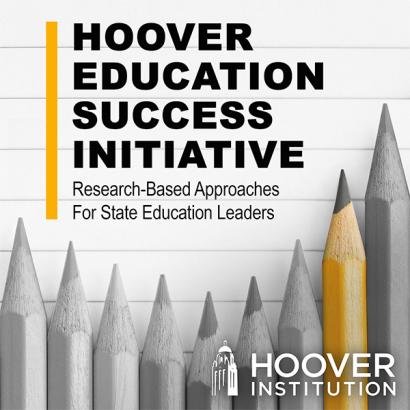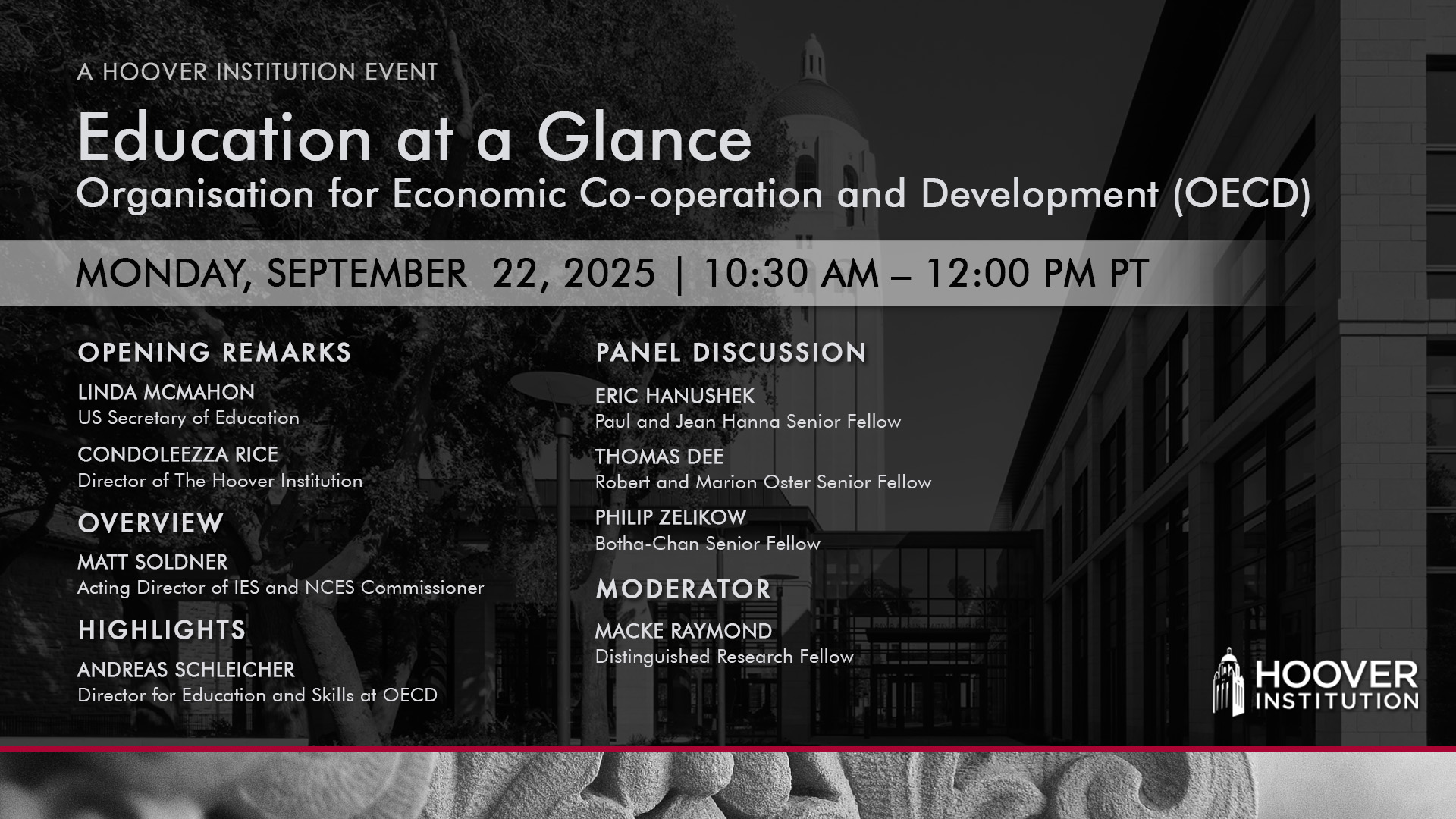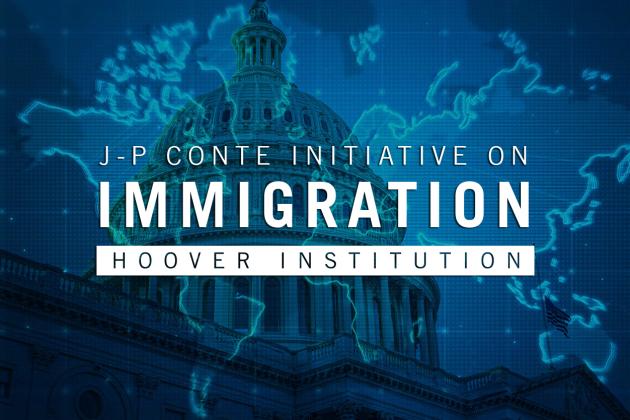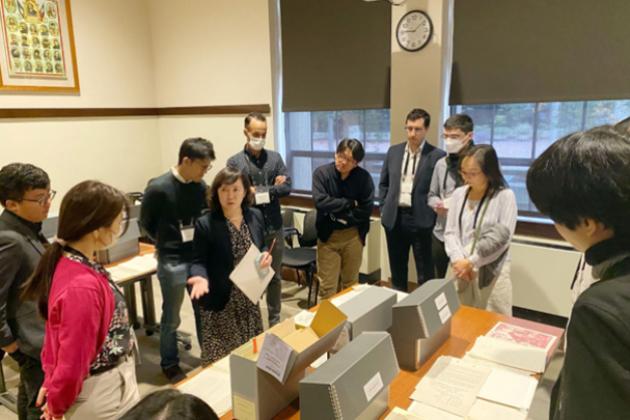The Hoover Institution is proud to present the 2025 U.S. launch of the Organisation for Economic Co-operation and Development (OECD) Education at a Glance report.
Education at a Glance is the authoritative source for information on the state of education around the world. It provides data on the structure, finances and performance of education systems across OECD countries and a number of accession and partner countries. More than 100 charts and tables in this publication — as well as links to much more available on the educational database — provide key information on the output of educational institutions; the impact of learning across countries; access, participation and progression in education; the financial resources invested in education; and teachers, the learning environment and the organization of schools.
WATCH NOW
>> Macke Raymond: Hello and welcome to the Education at a Glance PISA Results for the United States webinar. Thank you for joining us today for this important event. This event is a collaboration between the OECD, the US Department of Education, and the Hoover Institution of Stanford University. I am Macke Raymond, the director of the program on K12 education research at Hoover, and I'm serving as today's moderator.
This program is packed with star power. With much to share. We're going to begin with remarks from Linda McMahon, the 13th US Secretary of Education, and Condoleezza Rice, the 66th US Secretary of State and the eighth Director of the Hoover Institution. From there, we'll focus in on the US results, listening to Matt Soldner, interim director of the US Department of Education's Institute of Education Sciences, and Dr. Andrea Schleicher, the Director of the Directorate for Education and Skills at the OECD.
A panel of senior fellows from the Hoover institution will then join me for a discussion before opening the floor to audience questions. We're eager to begin, so I'll turn it over to Madam Secretary.
>> Linda McMahon: Thank you so much. And on behalf of the Trump administration, I'd like to thank all of you for attending this webinar and addressing with us a matter of utmost importance to our national interest and, quite frankly, to our future.
As President Trump has repeatedly pointed out, the health of our education system is equally critical as the productivity of our industries, the lethality of our military, and the integrity of our democracy. It is the foundation on which we will build a new golden age in this country, a better future where every single American has an equal opportunity to earn success and live the American dream.
A Better future. This future begins now in our classrooms, our textbooks, our parent teacher conferences, our apprenticeships, and our tutoring programs. We should not be satisfied with a nation's report card where 70% of 8th graders cannot read proficiently and 40% of 4th graders cannot read at basic level.
We should not be satisfied with a post secondary system where 45% of college graduates, a decade after they graduate, are working in jobs that don't require their degree. These failures should push us to strive and to question how can we serve our students better. We're addressing these problems as a nation in the nick of time.
Artificial intelligence is rapidly transforming our world, reshaping industries and redefining the skills our students need to thrive in the 21st century. We must strengthen our education system not just to offer our children better lives, but to equip them as leaders in innovation, which is essential for America's competitive edge in the global arena.
We are in untested waters. We need time tested solutions and innovative education leadership. The Trump administration seeks to apply proven solutions to education that will restore American greatness. We will trust parents to choose the best educational fit for their children. School choice. That means engaged, enthusiastic students who learn in unique ways and work toward clear goals that they are excited to reach.
Students who benefit from school choice will go on to engineer new technologies that unleash nuclear energy, design architectural achievements in cyberspace, and land astronauts on the moon and on Mars. We will also count on state leaders to take more ownership of of their K12 districts, their teacher training, their workforce development programs and their universities.
The age of ideological indoctrination and low quality education that serves special interests is over. This educational crisis demands a singular focus on meaningful learning as the foremost mission of every institution, every teacher and every administrator. States who prioritize meaningful learning will become exemplars of American excellence. And what is meaningful learning in the AI era?
This is especially important. How can we empower students to use such a new and qualitatively different technology without being intellectually limit limited by its convenience? And I think that's a big question. As you know, the White House is embracing the AI future with open arms by ensuring that young Americans understand how to use AI responsibly rather than outsourcing their thinking to a machine.
This is the approach of our administration to creating a better future in every area. Effort and excellence, personal ownership and responsibility. Nobody will create a better future for us. Every student, teacher, parent and education professional must dedicate themselves to work hard every day toward getting there. I hope you were challenged and encouraged by that thought, as I am.
And I hope that today's Education at a Glance presentation will arm you with the information and context to illuminate the path towards this better future. At this time, I'd like to welcome Dr. Condoleezza Rice, Director of the Hoover Institution, to offer her remarks. Thank you, Condi.
>> Condoleezza Rice: Thank you very much, Madam Secretary.
And let me say it's really a joy to share this platform with you. We've known each other for a long time and I know of your bedrock dedication to the future of education in the United States, to the future of our children. I know that you agree that there is no more important issue for a democracy than to make sure that every child has the opportunity for a high quality education.
I wanna thank you for taking on this role in the Trump administration. Having done public service myself, I know it's not always the easiest thing so. So thank you for your dedication. And please, to all in the administration, including the President, who wanna see our children have a bright future, I'm grateful.
I'm also grateful that at the Hoover Institution, we're able to provide a panel of fellows who will talk about this important report coming from the oecd because we need to always ground our policy recommendations, our hopes and our concerns in reliable data. And the PISA group and the OECD provide that data to us, reliable information that we can trust so that we can make the very best decisions.
At the Hoover Institution, we spend a lot of time trying to shed light, not heat, on these issues. And so I wanna thank Macke Raymond, who is leading these efforts and will moderate today, because there's no thing more important than to be able to take this research and this data and to make it serviceable to people who have to make big decisions about the future of education.
I wanna thank Andreas Schleicher as well, and the OECD. I can tell you that when I was Secretary of State, when something came from the oecd, I trusted it because I knew that it was an effort to make sure that we were grounding our policy in reliable data and in information.
I also want to just say on a personal note that there are a couple of reasons that I believe these moments when we look at education at a glance, when we look at how American students are doing with the rest of the world, why I think that's so important.
I grew up in segregated Birmingham, Alabama, but my parents were absolutely devoted to the power of education. In fact, in my family, it was faith, family and education. And education was the way to make sure that they could never take from you the education that you had received.
Our children deserve that they deserve, especially in our democracy, a chance to be full participants in that democracy. And it starts with a high quality education. I also want to underscore something that Secretary McMahon that Linda just said. These are particularly important times to make sure that our children are getting a high quality education, K through 12, because the world that they are going to face is a world that's very different than the world that we faced.
Yes, technology has always been an accelerant of economic development. It's always been a challenge for those who were left behind. But the speed now of the technological revolution in AI and in other areas is going to challenge us as societies to make sure that our children, from the very beginning are able to access these technologies, that our teachers know how to make use of the technologies to make their students more capable.
And that as a society, we continue to train and retrain people in our workforce, and so that the AI and these other technologies are in fact, accelerants of their prosperity, not a detriment to them. This is an especially challenging time. And I'm just very pleased that we've been able to partner with our Department of education and Secretary McMahon and her staff, and also with the OECD to have a webinar about what the data that we will see will mean in Education at a Glance.
And perhaps most importantly, how we use it as a challenge and inspiration to move forward in every aspect in our public schools, in school choice for parents, which I am a big proponent of that, because parents need a chance to choose the best options for their kids. But if we don't take this moment as a democratic society, if we don't take this moment as a country to rededicate ourselves to the proposition that no child can be left behind, every child deserves a high quality education.
We will pay for it. We will pay for it in our economic prosperity, we will pay for it in our military preparedness. We will pay for it in our international leadership. Something that I cared a lot about, obviously, as Secretary of State, but we will pay for it in the fabric of our democracy in the United States, we are not held together by ethnicity or nationality, religion or creed.
We're held together by a very simple idea. You can come from humble circumstances and you can do great things. We're held together by the view that it doesn't matter where you came from, it matters where you are going. But the key to that is a high quality education.
Thank you for giving us this opportunity with the OECD, with the Department of Education, with my friend Secretary McMahon, to have a moment to reflect on what we know from the past and the work ahead of us. Thank you very much.
>> Macke Raymond: Thank you, Secretary McMahon and Dr. Rice.
Before we continue, I invite the audience to use the Q&A icon on your menu bar to submit your most probing questions. Questions only, please, for later in the program. And now it's Matt Soldner's turn to share his thinking today. Over to you, Matt.
>> Matt Soldner: Thank you, Macke. It really is a pleasure to join Secretary McMahon and Secretary Rice today to celebrate the US release of OECD's Education at a Glance.
Now, celebrate might seem like an odd word to use in this setting. We don't usually celebrate of the statistical publications, but I think we should. Almost 33 years ago to the day, September 24th, 1992, in fact, OECD released its first edition of EAG. And in its inaugural press release, it promised to be the most wide ranging and reliable set of international education indicators ever published.
And I think it has lived up to that promise. In just a few minutes, we'll be joined by Andreas Schleicher, director of Education and Skills at OECD, and he will share key findings from this year's EAG. And those findings are, I think, uniquely valuable to us. They summarize, of course, a set of key national statistics about the condition of education in the United States, statistics that you might find in our own digestive education statistics.
Uniquely though, they provide us a way to better understand the American system of education and training within the larger context of the developed world. This includes information on inputs to learning, such as the financial resources invested in education, the process of schooling, such as access to and participation in educational programs and teachers, the learning environment and the organization of schools, and, critically importantly, the outputs of educational institutions and the outcomes associated with learning.
As you will hear in just a few moments from our colleagues at the Hoover Institution, the insights that can come from official statistics, including comparative international ones, are critical for education policymakers at all levels of government. Now this is because education statistics don't just describe students and schooling as they are today.
These statistics give us a window into a possible future. Every time I talk about what 4th, 8th, and 12th graders know and can do, or the Federal, state, and local investment in schooling, or high school and college graduation rates. Today, I'm reminded that those statistics are harbingers of things to come about the lives of individual Americans, about the health and vitality of the nation's economy, and about our competitiveness and security in the world.
But of course, it's important to remember this future is squarely within our control, particularly if we allow high quality data to guide our decision making. And so I'd urge you all to listen carefully to my Hoover colleagues about not only how these data might be used by educators and policymakers, but what these data mean for us all.
Now, notably, as we celebrate the US Launch of EAG, we have to remember that the data you're about to see and you find there didn't just come to be in the US as is true elsewhere, each nation's data are domestically produced and voluntarily shared with the OECD. Most of the US data you find in EAG were initially produced right here within our national center for Education Statistics, part of the US department of Education's Institute of Education Sciences.
And they are the products of data collections which many of you are already very familiar with, including our Common Core of Data and our Integrated Postsecondary Education Data System. But I wanna remind you all that we do not do this work alone. High quality official statistics are the product of a robust system, and that system involves the whole of government.
And that is particularly true when we think about education statistics. We would not be able to talk about education and poverty if it were not for the Census Bureau. We would not be able to talk about education and employment were it not for the Bureau of Labor Statistics.
Programs such as the American Community Survey and the Current Population Survey are integral to our work here at NCES and the larger department. In fact, without the work of our nation's 13 principal statistical agencies, we wouldn't be able to talk about many of the factors beyond the classroom door that affect teaching and learning.
This includes early childhood experiences, school nutrition, student health and well being, housing instability, juvenile justice, and many, many more. Finally, I'd like to offer a word of thanks to those who ultimately make all of this possible and today possible. The public. The public's confidence in the Federal statistical system is critical, both as providers and as consumers of data.
Without information provided by the public, the mirror that official statistics provide about the condition of our nation would grow hazy, something that we can ill afford as we face an ever more competitive and complex world. So with those words, and without further ado, let me turn the floor back over to Mackie and to Andreas, who is about to walk us through some highlights of the 2025 Education at a Glass.
>> Macke Raymond: Thank you, Matt. That was excellent. I particularly like the idea of the way you integrated data into so many facets of our American life. I now would like to turn to Dr. Andrea Schleicher for the moment that we've been waiting for, the big reveal. Dr. Schleicher.
>> Andrea Schleicher: Thank you Secretary McMahon and Secretary Rice, and also thank you, Matt, for your kind words of introducing the publication.
I'm really happy to share some of the results from this year's edition of Education at a Glance with you. You should see them now on your screen. And I'm gonna start with something that we all care about, that's the investment in education. How much do countries invest? The US devotes a very large share of its gross domestic product to education, particularly to tertiary education.
The purple segment of the bar here, that is college and equivalent. Altogether, it amounts to close to 6% of GDP. Only Norway, the UK, Israel and Chile invest a higher share of national income into education. Averages always hide a lot of variation. As you can see here, there is a large gap in spending per school student between Idaho and the District of Colombia.
You see, Idaho is more similar to a country like Lithuania, whereas the District of Colombia spends more than any OECD country. But money doesn't automatically translate into results. While money matters a lot for countries that invest very little, you see them here. On the left side, the horizontal axis is spending per student.
For countries on the right side, the relationship between spending per student and learning outcomes becomes rather 10 years. You can see the United States spends over 10 times per student than Vietnam, but doesn't get better results when we look at student learning outcomes. The country with the highest spending student performance in the OECD area, that's Japan, also is just an average spender.
And we can unpack that pattern. Japan and the United States hire a roughly equal number of teachers for every hundred students, as shown on the vertical axis. That's the student staff ratio. It's quite similar between the two countries, but class sizes in the United States are small, while the Japanese have very large classes.
So why would Japan have large classes when they have a good teacher supply like in the United States? And the answer is that the Japanese use the time of their teachers just in very different ways. First of all, the Japanese require their teachers to teach far fewer hours than the Americans because they want to give their teachers time to work with students outside the classroom setting, to connect with families, with parents, to work with each other, to advance their professions.
Plenty of investment in that. And that is particularly important for them in high school, where the discrepancy with the United States is largest. The second, the Japanese school days are much shorter than American school days. So now you ask, how can Japan achieve so much better results when they have far fewer hours of instruction?
And the answer is educational productivity so much higher in Japan, Japanese students learn much more in every hour than American students do. That has a lot to do with teachers. Now, the quality of education will never exceed the quality of teachers. That's obvious. And the quality of teachers has a lot to do with the work, organization and support for teachers.
In Japan and many countries, teaching is both financially and also intellectually attractive. By contrast, you can see that here the United States does not pay its teachers that well. Here you see the salaries of primary teachers relative to what other similarly educated workers will get. And the United States comes last in that comparison.
You can also see that some countries have made major efforts to increase the salaries of experienced teachers over the last decade. You see most of the blue bars in this chart going upward, but sometimes the focus was also on starting salaries. That's marked here by the green dot, but it's not universal.
You can also see some countries gone the other way around. Countries make different decisions as to who provides education. And both Secretary Rice and also Secretary McMahon talked about it. You can see the Netherlands, where all schools are privately managed and publicly financed, giving parents a choice. At the other end of the spectrum, private schools are rather uncommon in Ireland, so lots of variation.
And the United States is somewhere in the middle. Actually, the share of schools that are privately provided but publicly paid, you call them charter schools, is relatively small compared with many countries, particularly those countries at the left side. There's another important difference. In most OECD countries, private schools are, again, publicly financed.
And again, that is not so common in the United States. So in the Netherlands, Belgium, that's the predominant model of working of school, so that everyone can choose the model that works for them best. But the government ensures that there are good choices available for everyone. Let's have a look at college education.
Education is always an investment, but it also brings very high return for individuals. In the United States, the earnings of A Master's or PhD graduates are over twice as high than for someone who has just a high school degree, on average, at least. And that drives rising participation.
Since the year 2000, tertiary attainment in the OECD area grew by about 1 percentage point each year until 2021. Since then, a bit slower. I'm gonna come back to this. We're looking more at apprenticeships, vocational education and so on. But generally we've seen quite robust growth in college participation.
And there has been a kind of heated debate in many countries whether it's meaningful that more and more people go to college. Some fear that one day we will all have a college degree and work. For the minimum wage because there's gonna be a massive deflation of the labor market value of degrees and qualifications.
But when you look at the data, there are no signs of that yet. Both in the United States and on average across countries, the earnings advantage of. College graduates pretty much held its ground despite increases in supply. I think that's a really important point to consider. As you would expect, the earnings benefits vary widely between fields of study.
Like in other countries, STEM graduates in the United States get paid a lot better than, for example, graduates from health or welfare. And there's a lot we can do to help young people better understand where labor demand is going and better match educational pathways. This future opportunities information for young people, for prospective students is really, really important here to better match what people study with what's actually needed and brings good returns.
And you can see the pattern is not unique. But in the United States, those disparities are pretty large. While the returns are good, the costs are also very high. In the United States this is particularly true for college education. That's marked here by the red dot. Where the United States ranks second in spending per student after Luxembourg.
So it's quite a lot of money going into every student. And those costs drive high levels of tuition where the United States is almost a class in its own. Particularly when you look at private institutions but also on the public side, that's the blue bar here. After Lithuania and England, the United States comes third.
And I must say, in England, students get, there's still a lot more support than in the United States to cover their tuition costs with income contingent loan systems and means tested grants. So the United States stands out with a high kind of a private cost for people. But even after discounting tuition, you can see that lifetime returns remain very high in the United States.
You can see that here for a woman, where the earnings advantage exceeds half a million dollar that second after Chile. So a college degree remains a good investment for those who can afford it and that is an issue. While a college degree provides high return, in the United States, access to college education is highly uneven.
While close to 70% of young Americans with a college degree have parents who also completed college, only 22% of Americans whose parents just have a high school degree obtain a college education. And Secretary Rice, you made that remarks. We should not judge where people come from. We should be ensuring that they have the possibilities to go where they want to go.
And you can see there is still a large socioeconomic gap. You see other countries on the left side where disadvantaged young people have much better access to college education. In Denmark, you can see here the first country, now the share of disadvantaged young people who make it into college is twice as high as in the United States.
Even though in every country we see that still a lot of socioeconomic gaps in access to college education. And add to this that in the United States, alternatives to college are still quite rare. And where they exist, they are often a last resort for young people, not a first choice.
And let me dwell a little bit on that. The United States does offer alternatives to a college education. In fact, almost half of Americans who enter post secondary education go for a two year program. We call those short cycle programs. So that's where the United States actually ranks quite high, the availability of those programs.
But the labor market outcomes of those programs are still a lot weaker than in most other countries. You can see that here on the example of employment rates. And that sort of raises concerns about the labor market relevance of some of those programs. What international experience shows is that successful higher career and technical education extensively involves employers.
And that's still rarely the case in the United States. Engaging employers ensures that both the content of those programs, but also the provision are relevant and that funding of education aligns with the actual needs of businesses. So to improve the labor market relevance of these programs, short programs could use, you know, industry recognized standards to ensure comparability alignment with labor market needs.
Now, some countries like Sweden and Denmark, for example, explicitly regulate the supply. Of course, is based on labor demand. For example, in Sweden, only programs supported by employers actually receive public funding. So the integration of the world of work and of education is engineered quite deliberately and intensively.
So in short, lots of people go to short programs, but often with not so great labor market outcomes. Short cycle programs in the US also do not yield good earnings outcomes. As you can see here, young people with a two year post secondary degree earn just 11% more than those who didn't even complete high school.
And that's 19 million young Americans who are in that group is quite significant number. It's only at the college level, marked here by the red square that you can see earnings going up. But when you look at other countries, you see that having well paid jobs with less than a four year degree is actually quite well possible.
Now Austria has very strong career and technical programs at high school levels, some of which are connected also to post secondary learning. Much like early college credit in the United States. And the earnings of those who go for those programs are as good as for those who complete four year academic qualifications.
So there's a lot of scope for improvement of that sector of the education systems, giving young people more different opportunities to take ownership over what they learn and how they learn. Where they learn, whether at the workplace or in institutions, and so on. It is also striking that dedicated career and technical programs are nearly absent in the United States when it comes to high schools.
You can see here the United States gets a second last place after Mexico. Now they do play a big role in many other countries where they are designed for students who prefer more applied routes to learner rather than just sitting in a classroom. I look at Austria, where over half of young people actually prefer such applied routes in high school.
And our data show that countries with such opportunities have actually also fewer young people who are neither in employment nor in education. So I think there is also here scope for development. Finally, the United States remains a country that is attractive to international students. But the United States has not seen the kind of growth in this area that we have seen in most countries over the last decade.
The global leaders here are now Australia, United Kingdom, Canada, Austria and Switzerland, which have strong rates of internationalization and also strong growth at the very same time. But overall, we can see that chi is still growing, more young people go abroad for the purpose of study. I've talked a lot about degrees, but you know, what we also see is that degrees do not automatically translate into skills.
Here you can see the literacy skills of adults with different educational qualifications. In every country, college graduates marked here in blue demonstrate higher skills than high school graduates marked here by the little red square. And that's what you expect. You get a better qualification, you have higher skills.
But when you look at this across countries, you can see that a college degree can mean very different things. You can see, for example, Finnish high school graduates, they've just completed schools and they demonstrate the kind of skills that we see only in college graduates in the majority of other countries.
So you can see exceptional quality of schooling, which then translates into strong skill levels that actually get you the same result which other countries achieve much later through college. Obviously these are literacy and numeracy skills. That's not everything. Our data also show that a significant share of high adults have very low skills.
In the United States, you have about, you know, almost, yeah, 28% of adults who do not read as well as what you expect from a 10 year old child. Now, of course, majority of people get beyond that, but the share of very low performers is high. And you have some countries, if you go to the bottom of the scale, Chile, Portugal, Poland, where it's getting close to the majority of people.
The most distressing result is that in the United States, but also many other countries, the skill levels particularly Those of those with low qualifications have actually declined over the last decade. So if you look at the skill levels, particularly of those who haven't completed high school, the United States and many countries are worse off than they were 10 years ago.
And that's something, I think, that is not a good sign of education. Well, let me conclude with a brief comparison of the early years, the other end of the spectrum. That's also what we pay quite a bit of attention to in education at a glance, because that's where we lay the foundations of opportunity, particularly for children from less privileged backgrounds.
The early years provide very important foundations for learning and it is an area where we have seen a lot of change in many countries over the last years. When you look at 5 year olds, you can see in most countries the enrollment at the age of five is not pretty much universal.
Even if you go at the age of four or three, you can see some countries have made education, access to education pretty much universe. That's not the case in the United States. And where the gap becomes most clearly visible when you look at the youngest, the three year olds for which we have comparative data.
Well, those were just a few highlights from the publication. There's a lot more in the publication that you find on our website and thank you again.
>> Macke Raymond: Well, thank you, Andreas, for a very provocative presentation. At the risk of sounding like a fan girl, I just really want to acknowledge the huge effort that has gone into producing this kind of comprehensive picture and to acknowledge that you have really driven this into a global phenomenon, something that I hope you are proud of and that we deeply appreciate.
I wanna encourage the audience to take advantage of the report. And at the end of our webinar we will also be posting the QR code so that you can take a picture of that and download the report. As the Hoover Fellows ready themselves for their panel, I also would like to remind you that the Q&A function is available to you.
After the Fellow's remarks, we'll have a few moments of internal Q&A across the panelists before we open it up to questions from the larger audience. At this point, let me introduce our panel. We're going to be joined by three Hoover Fellows. Thomas Dee is the Barnett Family professor at the Stanford University's Graduate School of Education and a Senior Fellow at Hoover.
Eric Hanushek is the Paul and Jean Hanna Senior Fellow, and Philip Zelikow is the Botha-Chan Senior Fellow at Hoover as well. We'll begin our presentation with Tom Dee.
>> Thomas Dee: Great. Thank you, Macke. And thanks to our distinguished hosts for inviting me, and especially to the OECD and its member nations, for continuing to collect and report out these data and as Macke noted, they are indeed quite comprehensive.
I couldn't help but notice that At a Glance is in the title, but this publication is actually 541 pages long, so I'm left to imagine the scale and scope of what the OECD could produce with a lingering look. It should go without saying that collecting such data is clearly necessary for understanding where we are as a nation and a globe, and for providing fresh new insights into how we might realize our educational potential.
And I would also stress they're critically relevant at a time when objective truths are often contested. However, adding to all this, a broad point I'd like to make is that, at least in the US context, such data are often misused, I think, in policymaking and discourse. Specifically, I often hear provocative international comparisons like those in this report, used uncritically as hard evidence in support of a particular policy position, frankly often an ideologically coded one rather than an evidence based one.
However, such comparisons aren't really convincing evidence on the impact of a policy choice or of a particular system design, as they're confounded with so many other factors that differ across international contexts. Using cherry picked elements from such reports is often nothing more than a rhetorical effort to score political points, more than an effort to expand educational opportunity.
And that's frustrating to me, because much of the real value I see in these data instead involves how they can encourage us to think more boldly about the policy innovations we might pilot and study. I really wanna underscore the difference I have in mind here. These international comparisons, I believe, function best not as a sock puppet for prior beliefs, but as an invitation to pilot and critically examine new innovations with some agnosticism and humility.
Frankly, this sort of ambitious inquiry mindset is especially needed in US education policy at this moment. There are important pockets of innovation in US education policy, but I also see far too much torpor and indifference to improving education educational opportunities at scale. The kind of rededication to education that Dr. Rice referenced is uniquely important right now for our national future.
Anyway, to underscore what I have in mind in terms of using the EAG report and its data to improve education research and policy, I just wanted to build briefly off of two sets of findings in the report discussed by Andreas. The first involves teachers, and Andreas mentioned really quite striking distinct differences in working conditions for teachers across the globe, particularly highlighting the US Japan comparison where in the US we see teachers engaged in comparatively long instructional time for comparatively low pay, but also with pretty small classes.
This is suggestive of any number of things, but to my mind it's particularly a reminder that the way in the US that we train, select, compensate and promote teachers should not be understood as a fixed parameter of nature. It's something that grew to some extent through historical accident, and to not recognize that is to invite a failure of imagination around how we might do better.
And this is really important because one of the major lessons of the last few decades where richer and richer data on students has become available to us is to underscore the first order relevance of teacher quality. High quality teaching changes lives, and we are still not doing enough to ensure broad and equitable access to high quality teaching.
Now we do have some models of how we might get to a different and better equilibrium in the teacher workforce from places like Washington D.C. and Dallas. But we've also seen failures to replicate these reforms elsewhere and really to fail at the implementation of them has led to some confusion and exhaustion, I think, in the policy space.
I also wanna underscore something else Andreas mentioned around the evidence of higher education productivity of teachers in Japan relative to the us. I mean, this underscores for me also just that research needs to provide more practice oriented advice to teachers. I recently wrote an Op-ed in Education Week where one of the facts I surfaced was focused on IES practice guides.
If you're not familiar with these, these are reports there have been about 30 produced over the last 20 years where IES thoughtfully gathered expert panels across a multitude of questions of practice and asked them to coalesce the best advice for schools and teachers. They made 153 explicit recommendations, but then IES rated these recommendations on the quality of the underlying evidence and nearly two-thirds of these recommend had nothing more than correlational or kind of anecdotal support a belief that they might work.
I think that's an embarrassing harvest from education research and we need to do better. But even when we do have good knowledge, we also need to make sure it gets translated into practice. Andreas also mentioned low literacy rates in the us we do have a better sense in particular for early readers about how best to promote literacy, but we've had trouble infusing that into teacher training and into classroom practice.
Now there's a bit of a moment now for the science of reading scoring victories at state houses, but I am particularly concerned that that victory may be a short lived one if it doesn't reach classrooms, if it doesn't foster change in teacher training programs. So that's one broad point, a second issue I wanted to underscore, and a final one, involves secondary to tertiary transitions.
Andreas mentioned that there's something distinctive about these so called short cycle tertiary programs, things like community colleges in the US in particular. They're uniquely common, but the employment rates for these short cycle programs are fairly low. This raises a variety of questions, but one broad one that it catalyzes for me is how we think about and maybe should rethink the design of the American high school.
The modal structure of the American high school is really oriented towards college prep. But it's important to remember that only 87% of the students in those high schools are going to graduate and some smaller fraction of them are going to go on to college and some smaller fraction of them are going to complete a baccalaureate degree.
And you see this in the National Center for Education Statistics data. Only 40% of young adults, those age 25, 29 have a bachelor's degree or higher. That implies for a majority of the students sitting in high school, they aren't necessarily being served well. That raises questions for me about what to do.
I see two broad paths here. One is to do better for those students in terms of their opportunities to enter and excel in college environments. And we can do that, for example, through providing broader access to rich academic content. One of the most exciting reforms in the US to my mind right now, are automatic enrollment policies that seek to place manifestly capable students by default in the advanced coursework that they're capable of thriving in.
And schools can also do more to offer more rigorous courses, advanced placement IB courses, and do more to embrace what we do know about effective pedagogy. But I think there's more we should do as well. In particular, the college only focus of American high schools I think is inadequate.
We should be thinking about a conscious design of high schools for both excellence and equity. And we're seeing promise in research along these lines in terms of innovative new career, technical and education models that have shown great promise in promoting economic prosperity for students. This includes things like career academies, but also pathway programs that link high schools with these so called short cycle tertiary programs, things like community colleges and local employers.
Those types of partnerships engage high school students, keep them from dropping out, and give them a reason to show up because they see a viable economic pathway towards prosperity and realizing their dreams. So I'll conclude there but I look forward to hearing from my panelists and from the audience.
Thank you.
>> Macke Raymond: Thank you, Tom. Let's turn now to Eric Hanuschek.
>> Eric Hanushek: Well, thanks so much for having me here. I'm particularly happy to participate in this panel because in 1992, when the first Education at a Glance report was coming out, the OECD actually asked me to give opinions on whether it would be a valuable thing for them to do and whether I liked the format.
And in fact, I thought it was a good idea then. And it has so grown, as Tom says, to 541 pages of really interesting material. For a long time, the general US attitude has been that there's nothing to be learned from other countries. The general statement is, well, we do education better than any other country.
We're happy to teach other countries what's going on, but we aren't going to learn anything from what other people do. What's become apparent recently is that that's not, in fact, the case. If I look at Andreas own data, the US is 30th in the world in terms of the production of people with master's degrees or more.
This is not the top of the world. You can see the same if we look at high school completion, even. And yet we're spending a lot of money. As Andreas pointed out in his presentation, the money spent doesn't always indicate the outcome. The things that Tom has pointed out, too are interesting that when we look at one country, you often focus on what's going on in the United States and not thinking about other places.
But other places are facing teacher shortages and trying to deal with them. Other places are facing teacher exit rates from schools, and an aging of the teaching force. And so there's things to be learned. Now, let me not focus on the issues because Andreas has given us a lot of issues and Tom has also given us another way of looking at much of the data.
Let me just talk first about Education at a Glance in its entirety. The one thing that EAG Education at a Glance has done is to first worry about providing comparable data so that we can actually learn something from other countries. Secondly, if we look at education at a glance, we find that it selects topics, the topics change regularly, but it's trying to stay up with what is the world thinking about and what are the issues that are important.
Thirdly, I would sort of underscore what Tom was saying. I think what Education at a Glance does is to basically generate hypotheses about things that might be important. It doesn't provide full analyses. And in fact, much of this depends upon outside research, some of which research hasn't been done yet.
The choice of topics mirrors in some sense the research that's going on, but it doesn't give all the answers. It says, let's look at these important patterns and try to figure out what they are, but they're not ready for policy yet. That, I think, is the strength and what the US should get from Education at a Glance.
Education at a Glance has also become really interesting over time, since 1992 when it started. One of the reasons why is that OECD has been so innovative and aggressive at recording key data elements about schools and what's going on. The development of the Pisa exams, which test 15 year olds in reading, science and math around the world every three years, provides a good example.
We can now go beyond just saying, well, Luxembourg spends more than we do or we spend more than Chile, but we can now look at the kinds of results that are obtained. Similarly, in this latest version, it emphasized material from what's called the peacock, which is the Program of International Assessment of Adult Competition Competencies, which is a unique survey that has in fact recorded both labor market and other observations of a representative sample of adults in many or almost all OECD countries.
But it's also at the same time measured their skill level, as we find in the standard math and science tests. And so by going beyond just the traditional measures of quantity of schooling, whether they've got tertiary degrees or so on, it's trying to get at the skills that are important.
And what we found is these skills are really important when we look at the labor market. So I don't think we should think of Education at a Glance as just a compendium of data. It's not the digest of education statistics. In many ways it gives broad data about education at all levels, but it also focuses on specific areas and these items change.
So in many ways it looks like our conditions of education, which picks relevant topics and then moves with them. So let me just conclude, so that we can get on to questions and answers. But I think that the answer is that the US needs to pay more attention to the rest of the world in terms of education policy.
Our declining achievement over the pandemic and even before is matched by what we see in some other countries, but not all. There are a number of countries that even during the pandemic, improved the performance of their students. And so we have to try to learn how did they do this?
So that we can in the future improve our performance. The second thing that we learned from looking at the large picture is that it's not going to be possible to wholesale adopt the educational system of another country like Finland. But we can learn from them and that's where we have to go.
So I'll stop there and turn it back over to my colleagues and then we can pick up in questions and answers.
>> Macke Raymond: Thank you. And now it's time for Phil Zelikow.
>> Phil Zelikow: Thanks, Macke. And forgive me, my voice is a little bit hoarse today. This is an extraordinary opportunity.
And I was thinking, I used to be an elected member of a school board. And I was asking myself if my colleagues on the school board said, hey, you went to this neat talk on the OECD stuff, what are the takeaways from that? I tried to think about how I boiled down the takeaways for my school board colleagues.
First of all, I'd start by saying we're in a period of extraordinary possibility and change in education. And boy, it's really interesting that we can now use this multinational laboratory in all the interesting ways Rick Hannah Shek was emphasizing. And then I say, out of the lab, I'm getting three big points.
If I, if I go more than three, my friends probably won't remember the fourth or fifth ones anyway. So I'll stick with the three. See, I too have been a classroom teacher. All right, point one, the structure of the system. The data suggests a really interesting combo of abc, a private choice.
I think a lot of my colleagues have no idea that the Netherlands has this all private school system that's publicly financed. They probably have an image that it's an one size fits all public school system because they're Europeans and liberals and they probably do things like that. So I think the notion of private choice, A, B, publicly supported, plus C, accountability.
Private choice, but publicly supported with accountability, A,B,C. Cuz one of the takeaways I get from the whole study is this is a study that tells you how you did on your homework. This is a study that allows you to get grades. And if you don't have grades, you don't have accountability.
So this is a study that's giving national grades. Well, every school needs to have that kind of accountability too. So that's my first big takeaway is that there are some interesting ideas here about structure that's emerging across a bunch of different countries. Second big takeaway. This has to do with what's going on in the schoolhouse.
It really makes it clear, and Tom Dee raised this point too, that the way we do things in the schoolhouse is actually more important than the money input. You need money up to a point, but after that it turns on how you organize the schoolhouse. And there I'm really struck by the idea that class size could be becoming an outdated concept.
We're so used to thinking about class size since we all grew up on the assembly line model. And on the assembly line model we wanted there to be fewer of us so we could get more time and attention from the teacher. But I think going forward with AI and some of these other uses of technology that we're going to be individualizing education in ways that we're only beginning to grasp.
But the point I'd stress, and the Japanese numbers help bring this out, is that using all these new tools is labor intensive. You need guides, tutors. Individualized education is labor intensive. People think about technology as a substitute for the teacher. It's not. It enables a different kind of education in which teacher quality is still really important.
But in the Japanese case, they're just using teacher time and student time in different ways. So that might get us past thinking of class size as the be all and end all and more thinking about how we design education in which we partner high quality teachers with high quality technology for a new kind of awesome educational product.
My third takeaway is that the United States has a CTE crisis. This was just a striking thing for me from the data and Andreas brought this out really well and so did Tom Dee. Tom was basically saying we may need to revisit the default model high school, which is college prep in a country where the majority of the kids are not going to earn a baccalaureate degree and aren't ready for that.
Here's the thing that strikes me. I developed a course for the Coursera platform that's been offered to tens of thousands of students all over the world. The education is going on all life long and it's CTE and skills education. The skills may be, I'm 40 years old and I want to learn art history.
Okay, we have to reconceive the way we do education. That's not all about the assembly line to train people to work in the factory, in the office. But it's all about functional skills. And the functional skills are needed on a lifelong basis. And now we're really reconceiving the educational system.
It may be too that we're reconceiving what colleges do and the role colleges play. I think that issue is going to become more and more important in coming years. My son is a coder. He regards his college education as useless for this career, but he's doing okay just the same.
We have to then we have to have an education system that meets people where they are. And I think the CTE skills problem, the failure to partner with businesses in the American system that Andreas really brought out, what a striking finding that is. And notice that the partnership with businesses doesn't have to be a physical apprenticeship at the big factory down the road in the virtual age, you could be apprenticing for a company that is 1,000 miles away.
So those are my three big takeaways about the structure, about the way you design what goes on inside the schoolhouse, and class size, and about CTE and skills.
>> Macke Raymond: Thank you, Phil. That was terrific. Thanks all of the panelists for great ideas and insights. Before we turn the floor over to an open Q&A session, do any of you have questions for any of the other of you?
>> Phil Zelikow: I have a question for Macke Raymond.
>> Macke Raymond: Okay.
>> Phil Zelikow: What did you think about the slide deck?
>> Macke Raymond: Well, I shared many of the ideas that have already been expressed this morning. I think the most valuable insight that I got here is that we are not listening to other countries in the ways that we could and should.
I think we miss a huge opportunity. I also wanna say that there is an unspoken sort of camaraderie to participating in these large scale assessments that I don't think we give adequate credit to as both establishing credibility as a nation to participate, but also then drawing them into the querying and the self reflection and the development cycle that comes as a result of seeing how you stack up with other nations.
Both of those things were very apparent to me in looking at these results and I think Dr. Schleicher did a great job of sort of teeing that up for us to see. Anybody else wanna ask anybody else a question?
>> Eric Hanushek: I wanted to make one statement that followed on to that that is not in this year's education at a glance, but was in last year's.
The US in the last PISA test was 34th in the world in terms of math achievement. Our 15 year olds were just beating out the Slovak Republic and losing to Malta, which I think ought to give us pause in the US about what we're doing and how we should think about reorganizing things.
It didn't appear in this year's EAG because it was in last year's and that was old news and we've moved on to new Data in the 2025 version. But these are the kinds of issues that I think are important when we talk about learning from other countries.
>> Macke Raymond: So I would like to suggest that we model.
What is a question? Was there a question in that, Dr. Hanushek?
>> Eric Hanushek: Andreas, am I correct in what I said about the PISA scores for the last round?
>> Andrea Schleicher: Yes, you were. And actually PISA is gonna come back this year. We have the 25th edition of PISA and you're gonna see that in 26 Verizon.
>> Macke Raymond: Thank you. I would like to now encourage all of the speakers who are still online to come off of mute and come off of blocked video. And we're gonna turn to some of the audience questions. I wanna thank my colleague Stephen Bowen for sitting in the background and harvesting the list of questions from the audience and helping us create a series of questions for the group.
Let me start with the first one. Building off of Phil's comment that choice is really an underlying phenomenon that is probably growing across the globe anyway, but has strong presence in other countries. It really requires that we have active and informed decision making by parents. And there is an emerging literature in the US about the fact that parents are not receiving as much Information as they might need in order to make strong decisions on behalf of their children.
And so the question is, what should we be thinking about as the necessary information for parents to grab onto and what is the responsibility of government to make those data available? So let me start with Matt on behalf of the United States picture, and then we'll go off to others if they wanna contribute.
>> Matt Soldner: Well, gosh, Macke, as a, as a statistical official, I don't make comments on policy, only about data. So let me see if I can find a way to honor that provision without totally dodging your question, that perhaps someone else might want to take a whack at it.
Certainly legislation requires that districts make available and states make available information about each of their schools through our accountability reporting system. But nothing substitutes for parents talking directly to their children's teacher about their performance, right? Cuz I think that's in particular what the research shows the parents are particularly bad at understanding their own students needs for additional support in the classroom and academic success.
So I would make the anodyne advice and let others say something perhaps more thought provoking to suggest that making sure parents feel that they are in a position to speak with their students, teachers and teachers are prepared to talk to parents about student performance perhaps is the best step to take it at a kind of hyperlocal level.
And glad for others to comment as well.
>> Macke Raymond: Anyone else? All right, well, then let's move on.
>> Thomas Dee: Andrea has his hands up.
>> Macke Raymond: I'm sorry, I didn't see. Your hand is up, sorry.
>> Andrea Schleicher: Thank you, yeah, no, I actually like also Philip's point, private choice, public support and accountability.
But accountability is not really enough. The public does have a responsibility to ensure that parents have good choices and also that parents are empowered to make good choices. And that doesn't come from the accountability system alone. When you look at countries that doing that really well, they have information systems that is digestible for parents.
It is transparent, it's easy to look up how your school stacks up with those of other systems. And I think that part is often overlooked. And you need to empower, you need to understand parents have their own needs, their own interests, and to make sure that there's a level playing field, I think is critically important.
You can look to Australia, you look the my school systems, Belgium, the Netherlands, they have very, very strong systems where parents and they are actually actively using that choice. They're re-allocating their children when things do not work as intended and so on. But that part goes beyond accountability and it's really critically important.
>> Macke Raymond: Thank you. I also wondered about what our panelists think might be done at the school level to leverage the kinds of information and insights that the Education at a Glance collection revealed to us today. Schools already in session. Plans are rolling for a year. Are there short cycle adjustments that schools can make that would be more advantageous for students and teachers?
>> Thomas Dee: Well, I'll jump in here to say one short cycle adjustment that I've really recommended that is unique to the US Context concerns the chronic absenteeism crisis we face in the wake of the COVID 19 pandemic. We saw that as students returning to school in the 2122 school year, rates of chronic absenteeism, broadly across all the heterogeneity in the US Nearly doubled.
Now it's been improving in the subsequent years, but it's still at least 50% or so above baseline, the pre pandemic baseline. And there's a lot of discussion around all the different things that schools might be able to do. But I've been arguing that as we think about this, we need something more like a Manhattan Project mindset that is just really focused on what works and what's tractable.
In particular, tried to underscore the imperative to be attentive to the things that are evidence based, low cost, and scalable. And in that space, something that really we could single out is low cost messaging to parents using real time attendance monitoring data simply to let them know that.
Their kids aren't meeting expectations and that that matters because part of the problem is there's been some erosion about the perception of the value of attending school regularly and parents don't always know how their kids are doing. So that strikes me as uniquely low hanging fruit. And it's available to schools now as they see their daily attendance data and could act on that in reaching out and engaging families.
>> Macke Raymond: So let's go to Hanushek for additional comment.
>> Eric Hanushek: I'm the last hand up, but I'll just quickly reiterate what Tom just said. In the last few years in Washington, D.C. there's been this sort of undercurrent argument that, well, schooling doesn't really matter, it's all just selection into schooling and that schools aren't doing anything for kids.
And in fact, we know that the US rewards skills as measured by these standard tests. That schools look at rewards skills more than almost every other country in the world, which read the opposite way, says the US punishes the lack of skills more than any other country in the world.
And so that is something that parents really need to understand. But Matt and Andreas also had their hands up before me.
>> Macke Raymond: Andreas, why don't you go next?
>> Andrea Schleicher: Yeah. The US is often portrayed as a country of local control, but when you actually look at this through the lens of schools, the degrees of discretion that schools have is actually way more limited than in the majority of OECD countries.
If you are a school leader in Sweden, you have to figure out how you pay your teachers and you can actually use a fair amount of discretion for that. If you're a school leader in Britain, you have to figure out how you combine, combine your space, time, people, relationships, technology.
Coming back to the question of Philip, if you decide as a British school, I would like to pay my teachers better or have better working conditions and then I increase the class or I reconfigure the concept of class. You can do that, in the United States those degrees of freedom are actually really limited.
And I think that that limits the kind of choices Macke, that you can currently make as a school.
>> Macke Raymond: Matt?
>> Matt Soldner: Yeah, I just wanted to pop in and put a number on Tom's observation, which I think is exactly right. In 2018 here at IES, we published a evaluation, a randomized-controlled trial of around 26,000 K5 students in four urban districts.
And among our students who evidenced the highest risk of chronic absenteeism, we were able to decrease that by 7 percentage points just by doing text messages. Exactly of the type that Tom was discussing, passing along little tips, volunteering the school assistant so you can do something that is exceptionally low cost, basically automated, and make a meaningful difference on this important metric.
>> Macke Raymond: Thank you. In the United States, we've been trying for decades to move the needle for kids and we've had reforms happening all the time, much as Andreas has been mentioning. A lot of them have been top down and sort of unitary, one size fits all handed down to schools and in the form of mandates.
What would the panel suggest as better strategies that we might think about to take the information that we've seen today and other sources to move the needle for kids and actually get a system that is more responsive to the job of educating our youth?
>> Eric Hanushek: You wanna start with small questions?
I guess.
>> Macke Raymond: You already got the small questions. We're going big now.
>> Thomas Dee: Well, I'll jump in cuz I actually wrote about this recently in an Op-ed and Education Week. Frankly, I think the entire ecosystem in the US that connects research, policy and educational practice needs to be really critically examined.
I mentioned in my comments that research hasn't provided enough practice relevant insights. And the IES has been fighting the good fight here for decades, right? And trying to build out the base. But despite its footprint, is still too small of an actor in terms of the broader research space.
And that's why we've seen such a meager harvest in those practice guide reports. So research needs to do better. Policy needs to be more conversant with research, both policymaker and practitioners. It's stunning to me to see evidence of just how they're not always well positioned to discriminate good evidence based insights from things that are frankly anecdotal or even marketing testimonials from firms.
And also when we have policy pronouncements getting them to drill down to changing what Philip stressed, what happens in the schoolhouse where the actual spaces where teaching and learning really occurs is important and it often doesn't punch through. And so that involves engaging school level and classroom level actors.
It involves better evidence, grounded professional development. And also I think we need to be more attentive to what teachers are learning in their pre service programs because far too much of it is unmoored from anything we would consider a strong evidentiary base. You ask a big question and you get a sort of broad set of criticisms, Macke.
>> Macke Raymond: Anybody else wanna pile on before we move on? Matt.
>> Matt Soldner: Just briefly, I think the other thing that you may not see in teacher preparation programs or perhaps even principal preparation programs. Where many of these decisions are made is the kind of coursework and the hands on practice required to evaluate research on their own abstinent intermediary, right?
And so we know that research is complex even when researchers make the fight, the good fight to ensure it's translatable. But if we are not providing educators with the skills and their preparation programs or the certification programs to consume that, absent intermediaries, I think we're missing an opportunity at the very least.
>> Macke Raymond: So I'm gonna throw a question related to this to Phil, because you've had the opportunity to both sit in an education space, but also sit in many other spaces. And I just wonder, are there other practices from other industries or other nations that you've seen that would enhance our up, uptake of insightful ways to innovate?
>> Phil Zelikow: Yes, but there's no one country that's the, that's the paragon. What I will say is you need to be able to bridge the gap between social science insight and practical action. So we're getting then a lot of social science insight. And okay, I mean, as a couple of people are alluding to, how do I change?
What exactly do I do? So I'm like, Andreas was describing things people are doing in Sweden. Well, what did they do? And the people who can come in with it doesn't have to be one particular move, but here are very practical steps. For instance, when we were just talking about the way of taking up attendance, that's a good example of it.
In general, the big problem in policy is on the outside. Policy consists of two things. Social scientists who have no idea how to turn their generalizations into practice, and politicians who just want to adopt poses and postures and positions that'll situate them in the right way for the culture war.
So what's in the middle? In the middle is the how to part. And if you could, the people who bridge the how to part, both in government and in the private sector, are the people who get their ideas turned into action.
>> Macke Raymond: Thank you. We have a question that sort of vectors off of that.
A member of the audience says that we are talking about learning from other countries, but those other countries don't look like us. They don't have the kind of diversity. They are smaller countries. They are more homogeneous countries, like Finland or like Japan. The question is, how much of their practice do you think would actually apply in the incredibly varied landscape that is the US education ecosystem?
>> Phil Zelikow: If I could jump in on that a little bit, please. The French and English cases. The French and British cases are very interesting. France and Britain are actually really diverse countries now and it shows in their classrooms. Now they have social segregation of different kinds, but you're seeing they haven't solved all their problems, by the way.
But you can see some of the numbers the British are getting and some of the OECD outcomes. Some interesting stuff in France, too. The way that one of the things that both the French and the Germans did well is because of the quality of the CTE education, it helps pull a lot of minority groups into the mainstream of the community cuz it plugs them into getting work.
And that's often a tip. Once they kinda get work in mainstream employment, that really helps solve a lot of problems.
>> Macke Raymond: Thank you, Andreas.
>> Andrea Schleicher: Yeah. Obviously you can never copy and paste a kind of system architecture, but you can ask yourself what makes a specific system successful, and how you can understand the drivers of the success, and how you can configure the drivers in your own context.
I mean, that's exactly what the Singaporeans have done for decades. If you go to Singapore, you'll find very few things they actually invented themselves. But they have been looking around the world for years, and they have never copied, but they have always reconfigured what others have done in their context to make it better than the original, in a sense, often.
And I think that's something that you can do. I think the example of CTE, there are plenty of really good solutions that work in very different contexts. The diversity argument is not really very strong. There are actually many OECD countries that are as diverse as the United States on almost any dimension.
Whether it's income, whether it's immigration, all of those things. If you worry about size use the state as a reference point rather than the United States as a country. I think that's lots of ways how you can actually navigate the world as a laboratory. Rather than trying something out yourself, figure out how this has worked in other countries when it was first used, and how you can make it work better.
And quite frankly, that is how many education systems have got where they are today. They didn't reinvent the wheel. They actually studied very carefully what works. They use comparative data and leverage this, I think, if you look at, do I invest in a better teacher or in a smaller class?
Look at what countries have done on that. If you ask yourself, how you set education standards in a more ambitious way, there are plenty of really good models. And once again, you cannot use the exact same ways, but I think there's plenty of scope for benchmarking and peer learning.
>> Macke Raymond: Thank you. That actually is a wonderful segue to a question that has been posed by several members of our audience, which is, given the fact that there's such diversity of results across the countries that you're talking about, Andreas, but in many of those countries, they also have strong union presence.
What experiences or levers have you seen other countries use to gain a cooperative relationship as opposed to a combative relationship with their unions? Is there any lesson there that we might want to think about here in the US.
>> Andrea Schleicher: It's an interesting question. In fact, every year we convene a meeting where we bring together the secretaries of education within union leaders to address some of those issues.
The nature of labor relations varies a lot across countries. But I also wanna make another point here. The nature of unions often reflects the work organization in education, if you have a highly industrial work organization, as you do in the United States, you are likely to get a very industrial union that worries very much about pay and so on.
It becomes very antagonistic, if you have a more professional work organization where teachers have more interesting, more diverse careers, where schools have more human discretion. Where they can use resources in a more flexible way. You get a very different nature of the relationship because the professional interests become very different.
I give you an example, in 1994, and tells you how long I have been in the OECD. That was my first year in the OECD. Sweden introduced individual pay, where school leaders had to decide on the pay structure of teachers. That caused a revolution. You had the unions on the street and so on.
And Sweden usually is a usual, very peaceful country. Four years afterwards, that system of teacher pay had a 70% approval rate among unionized teachers. So the unions changed. So in a way, I think, the work organization that you have, if it's highly standardized, highly industrial, you're very likely to get a very antagonistic, industrial, strong union.
If your work organization becomes more professional, more flexible, more responsive, you are more likely to see a union that engages more in the professional debate and dialogue. At least that's what we see every year when we have those events. It's just a very, very different dialogue across countries.
>> Macke Raymond: Well, thank you. It is always the mark of a great conversation that we wish it could go on longer, but we are at time. I want to remind the audience that our OECD report is going to be available on the OECD website. I know the audience would applaud if they were actually possible to do so.
But let me extend sincere thanks for the time and deep engagement from all of our speakers today. And thank you very much for joining us on this webinar. I hope you have a good day.
Opening Remarks
Linda McMahon, US Secretary of Education
Condoleezza Rice, Director of The Hoover Institution
Overview of Education at a Glance
Matt Soldner, Acting Director of IES and NCES Commissioner
Highlights of Education at a Glance
Andreas Schleicher, Director for Education and Skills at OECD
Panel Discussion
Eric Hanushek, Paul and Jean Hanna Senior Fellow
Thomas Dee, Robert and Marion Oster Senior Fellow
Philip Zelikow, Botha-Chan Senior Fellow
Moderated by
Macke Raymond, Distinguished Research Fellow



















